“Stories My Father Told Me” is a series of twenty-three gouache paintings by Lebanese-American artist Helen Zughaib. Based on the memories of her father, Elia, who was born in Damascus in 1927 under the French Mandate, this large body of work is filled with the recollections of his early childhood in the Old City of the Syrian capital and the subsequent years of his youth that were spent in the Lebanese towns of Zahle and Marjayoun. Beginning in 2003, Helen and her father collaborated on the series through sporadic exchanges that took place over the course of several years. After recording a specific memory or fable that would come to mind, Elia would give his written account to his daughter, who would then paint and document it; until one day he gave her what would be the final installment, a tragic tale of displacement that was painted as “Crossing the Litani.”
With these paintings, the artist recreates scenes that encapsulate the affectionate nostalgia of each tale and the whimsical sights of Levantine culture in urban and rural settings that are pieced together as though seen through the eyes of a child. Such stories take on elements of folklore as the process of sifting then recording occurs twofold, first in the form of a text then in its final stage as a visual representation. Woven throughout is a sense of longing that builds as Elia carefully recounts the encroachment of a modernity that cast certain traditions aside and the outbreak of war that ultimately led to exile. In many examples from the series, the viewer can also note Helen’s subtle reflections on her own uprooted life (an experience that seems to have forged an undeniable link with her father) despite the apparent focus on a specific period of Elia’s personal history.
Zughaib left Lebanon at the age of sixteen in 1975 when the start of factional warfare unstitched the lives of the country’s ill-equipped residents. Traveling to Athens, then Paris, where she finished her secondary education, she later moved to the US to pursue a degree in fine arts. Joining her family in Washington, DC after graduating from Syracuse University in New York, she continued to cultivate an aesthetic that ties in aspects of these vastly different locales, most notably in the visual cues and themes that position her figures. Often creating a narrative sequence across several paintings, with each new body of work she immerses herself in techniques and approaches that are drawn from various influences, be it traditional Arab art forms, European modernist movements, or an assortment of contemporary American standards like Pop art. These stylistic elements are reinterpreted according to the subject at hand, frequently with Zughaib’s playful brand of fusing identifiable references (and cultural signs) and always with an assiduous mastery of medium, color, and design.
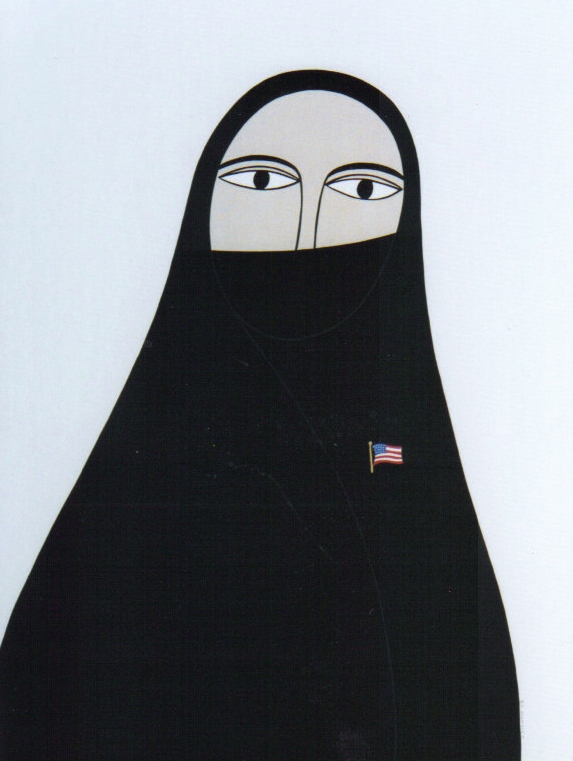 ["Abaya with Flag Pin" (2008) Copyright the artist.]
["Abaya with Flag Pin" (2008) Copyright the artist.]
Among the collection of paintings titled “Washington,” the United States Capitol is outfitted with a brilliant ornamentation that is more akin to the Umayyad architecture of Jerusalem’s Dome of the Rock than its sterile neo-classical façade. A later series titled “Changing Perceptions,” shows abaya-covered women adopting unexpected personas: as Frida Kahlo in the 1943 painting “Diego on my Mind,” wearing a niqab that is paired with an American flag pin, or blending into the geometry of a Mondrian-like composition.
While such heroines are central to her paintings as their images take aim at outdated (yet somehow universal) stereotypes of femininity, in 2006 they began to fall under the spell of an insurmountable sorrow. Zughaib’s “Weeping Women” series (2006-2009) was first inspired by the Israeli assault against Lebanon that left over a thousand civilians dead, a million displaced, and parts of Beirut and the country’s southern region in ruin once again. A new set of gouaches resulted two years later when she returned from conducting several art workshops for women in the West Bank as part of a program that was initiated by the US Consulate. In March of 2008 during this visit to occupied Palestine, signs of an impending war seemed to surround her as news of regular incursions and widespread harassment of Palestinian civilians was increasing, leaving the artist with an unsettling sense of foreboding. By the end of that year, Israel’s especially malicious attack on Gaza was unleashed, terrorizing an already battered and abandoned population; and more weeping women emerged. Stricken by moments of horror, these figures are painted just beyond the boundaries of an aestheticized beauty. There are no signs of gore or wide-scale violence, only witnesses and survivors who are so overcome by grief and fear that their faces become disfigured while their forms freefall into a nameless void.
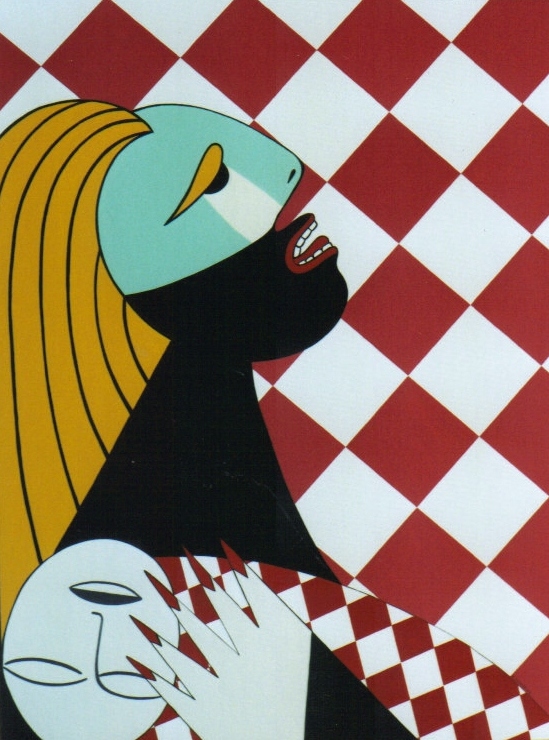 ["Weeping Woman with Child" (2008). Copyright the artist.]
["Weeping Woman with Child" (2008). Copyright the artist.]
In 2010, thirty-five years after being evacuated, Zughaib returned to Lebanon for the first time. When leaving as a teenager, she had been told that their stint away from home was only temporary. She travelled to Beirut, almost in a dream-like state, for a solo exhibition at Agial Gallery, one of the Arab world’s premier art spaces. Among the works that were painted to mark the occasion was “Circle Home,” a minimalist black and white piece that was created through the meditative process of writing a single Arabic word over and over again with diligent precision. Slowly moving out from the center with a degree of trepidation in an attempt to replicate “home” (an initially unattainable utterance), this cathartic process of executing a perfect sphere served as a symbolic exercise for her own odyssey, the circle of which was finally closed.
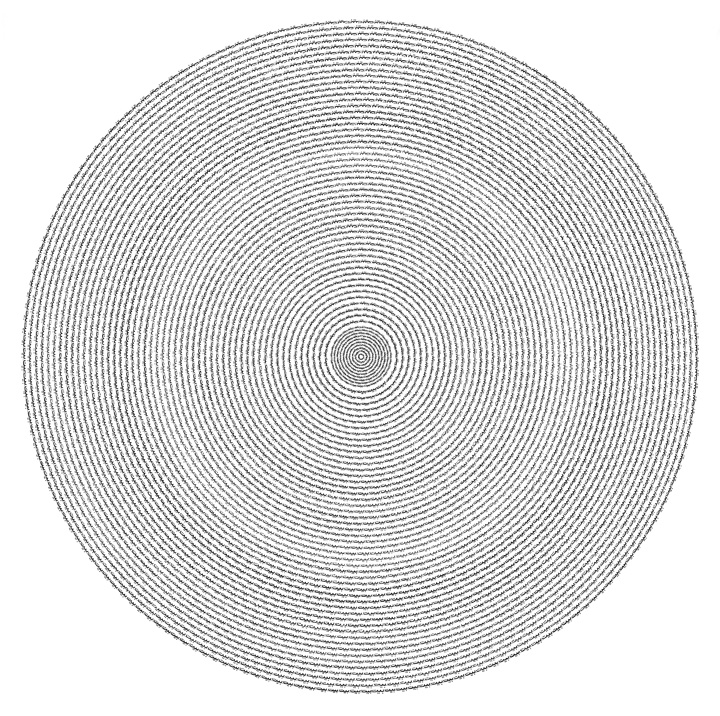
["Circle Home" (2010). Copyright the artist.]
In April, Zughaib was asked by the Arab American Anti-Discrimination Committee to present an artwork to the family of the late journalist Anthony Shadid (who was to be honored at its 2012 convention). Acting on the recommendation of her father, who immediately recalled the stone houses of Marjayoun when informed of this request, she offered “Circle Home” in remembrance of Shadid.
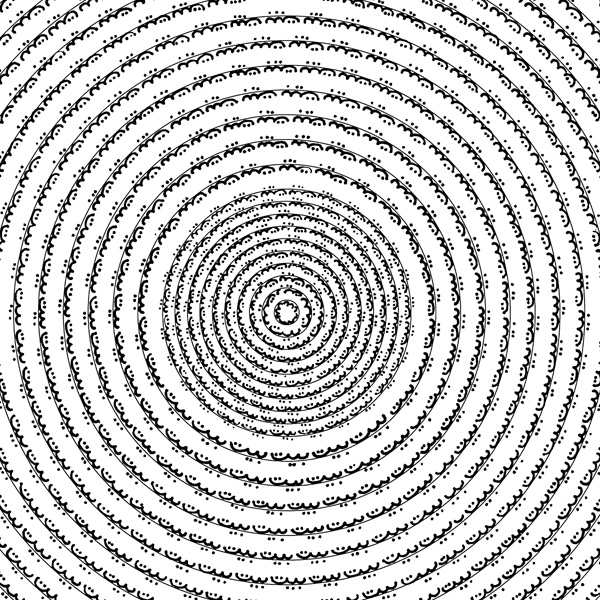 ["Circle Home" detail. Copyright the artist.]
["Circle Home" detail. Copyright the artist.]
Below is a selection from “Stories My Father Told Me.”
 ["The Hallab" (2004) Copyright the artist]
["The Hallab" (2004) Copyright the artist]
My father, as a small boy, living in Bab al-Mussalla in Midan, the old quarter of Damascus, remembers being fascinated by the various peddlers, who wandered the narrow streets chanting about their products and services.
Sellers of fruits, vegetables, sweets, as well as knife sharpeners, pruners and buyers of old items, filled the air with their melodic chants. These rhyming chants never actually mentioned the name of the item being offered, but described in detail the color, freshness and taste. Buyers knew by the traditional chants what was being offered for sale, which also would dictate the day`s menu. The streets were crowded with loaded donkeys, push carts and peddlers carrying large trays (sddur) piled high with cakes and other tasty things. Children playing in the street or on their way to school would also keep an eye out for the sellers of sweets. These were mostly seasonal. Cooked steaming sweet beets and popcorn were sold in winter. Ice with syrup (sweeq) was sold in the summer. Kaak and manaquish were sold year round. While tamari with molasses were sold only on feast days. Invariably, the daily allowance was exchanged for a kaak with za`atar, a tamari or a handful of hanblas, a tasty fruit that can be carried in the pocket without being damaged. Usually the sweets were shared or bartered with others, thus expanding the purchasing power of the daily allowance.
According to my father, the nicest of the peddlers was the Hallab who chanted about his fresh milk. The Hallab had a small flock of eight to ten Damascene goats. The goats were mostly brown, large and gentle. They had two dangling strands from their necks. The small children would stand eye to eye with the goats to pet and hug them on their way to school. The Hallab did not mind and both the goats and the children loved the attention. The Hallab carried a pail (suttle) and a measuring can (kaylee) and a long bamboo stick. When the housewife opened the door and asked for milk, the Hallab would milk one of his goats right there. If she planned to make yoghurt that day, more milk would be required. If the goats began to wander, the Hallab gently guided them back to the herd. After the fresh milk was delivered and the Hallab was paid, he continued on his route, chanting about his beautiful goats.
The other peddlers could not compete with the Hallab, his wonderful goats and the pleasure of petting the gentle and loving animals. My father remembers that after powdered milk appeared on the grocery shelves, milk never tasted the same again.
 ["The Show Box (Sanduk al-Firji)" (2005) Copyright the artist.]
["The Show Box (Sanduk al-Firji)" (2005) Copyright the artist.]
Long before cinemas or television entertained Lebanese children, there was the sanduk al-Firji.
Sanduk al-Firji was a brightly decorated semi-circular box that was strapped to the back of an itinerant entertainer. He would come into the village loudly chanting previews of the stories he had, going from hara to hara, street to street and ending in the village square.
First he unstrapped the sanduk. It was about eighteen inches high and had five or six glassed portholes equidistant from each other. On either end of the box were two small inner poles attached to a scroll with bright glossy pictures telling one or more of the fabled Arab stories such as "Antar and Abla," or "Abu Zayd al-Hilali."
He placed the box on a stool and set up a circular bench facing it. The village children took turns handing him their kharjiyyi, spending money, and in groups of five or six peeked into the box and watched the story through the portholes. The entertainer rolled the screen, chanting about the beauty of the ladies, the courage of the men and the strength of their horses. Usually, the lucky viewers would briefly give up their place to siblings or friends who did not have enough kharjiyyi.
When all those who wanted to see the show were accommodated, the entertainer strapped the show box to his back, picked up the stool and bench and walked to the next village, chanting previews and enticing new viewers.
It was an amazement to me at the time how he synchronized the chanted story with the pictures on the rolling scroll. And the box, the beautiful sanduk, with its colorful pictures and many tiny mirrors, was a source of wonder, even without the stories.
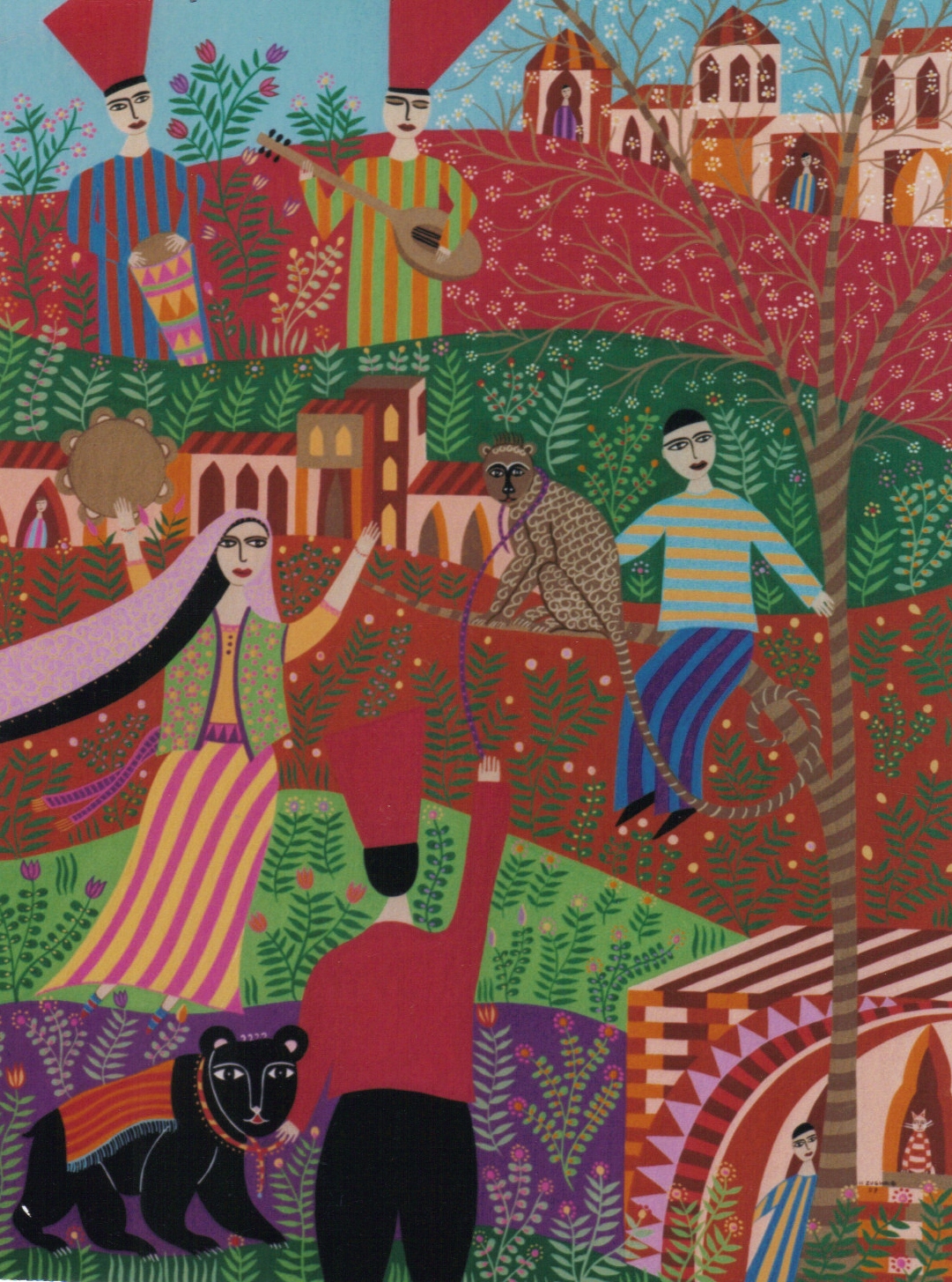 ["The Performing Bear, the Dancing Monkey, and the Dancing Gypsy" (2004) Copyright the artist.]
["The Performing Bear, the Dancing Monkey, and the Dancing Gypsy" (2004) Copyright the artist.]
My father, reminiscing about his early years growing up in Bab Al-Mussala, Midan, the old quarter of Damascus, described how on rare occasions he would hear the beat of a drum with the distinct chant about the performing bear and dancing monkey. This was one occasion no child wanted to miss. Children begged and pleaded for a few extra piasters to go see this incredible sight. One could also hear the jingling of a tambourine and the sing-song of a Gypsy. He sang and played his tambourine and bouzouk. He was accompanied by a young Gypsy girl in a colorful, flowered skirt, that twirled around as she danced. They went from hara to hara (narrow street), trying to entice new audiences.
The bear, on a strong chain, would obey commands, such as: how does a young bride walk, how does an old man sit, how does an old woman wash laundry or knead the dough. The monkey, also on a leash, would dance, do tricks, and pretend to be a pick-pocket. At the end of the amazing performance, the tambourine or drum was passed around to collect the coins from those who had watched the show. The troubadours then moved on to the next hara. Many times children would follow the Gypsies and end up getting lost. My father got lost one time and finally a kindhearted man lead him back to his own village and to Teta`s house.
 ["Blind Charity" (2005). Copyright the artist.]
["Blind Charity" (2005). Copyright the artist.]
One day, my father and I were chatting about everything and nothing in particular when he told me the following day he was going to Dayr Saydnaya and I could accompany him if I wanted to. The Dayr, a nunnery in the outskirts of Damascus, was his favorite charity. I accepted gladly, as this was one trip I enjoyed and looked forward to. He asked me what I thought of charity and I replied that people appreciate good deeds because such acts meet their special needs. He then asked me about blind charity, where the donor does not know the recipient and has no idea what the need may be. He proceeded to tell me a story exemplifying this kind of blind charity which he described as the most sincere.
Once there was a very rich woman, the wife of a governor of a prosperous port city. Once a week she would take a very big basket and seal it with tar to make it waterproof. In the bottom of the basket she would write a line from a poem, "Do charitable deeds even if they may be out of place, for no act goes unrewarded." Then she would fill the basket with food, water and clothing and drop it in the sea to be carried away by the waves and the wind. After some time, she and her family took a long boat trip to visit relatives in another port city. Heavy storms demolished their boat and many on board drowned. She also would have drowned had she not clung to a plank of wood. In time, she drifted to shore where she collapsed from hunger, thirst and exhaustion. She woke up in someone`s garden. The lady of the house told her the servants had found her on the beach and thought she was dead. But then realized she was still alive and so they brought het to the garden. The lady of the house said she could stay with them as a washer woman and she gladly accepted.
One day the lady brought a very big bamboo basket full of laundry and asked the woman to wash them. When the woman reached the bottom of the basket, she saw the line of poetry which she herself used to write in the bottom of those baskets before dropping them in the sea. She had recognized her own basket. She sat down and began to cry. When the lady came to check on the laundry, she found the woman sobbing. Asking her why she was crying, the washer woman explained that the basket was one of hers and went on to describe how she would fill them with provisions and drop them into the sea thinking that some shipwrecked people would find the baskets and use the food and water to survive. The lady was amazed and told the woman that once she and her husband were shipwrecked. They had lost everything. Then a big basket drifted by and they clung to it until they landed on shore nearby. When they recovered, they walked to the city, found jobs and in time, prospered. Out of sentimentality, they kept the basket and used it thinking that some day they would learn more about it and the line of poetry written on the bottom admonishing blind charity.
The lady took the washer woman to her own quarters and when her husband returned home, told him about the day`s events. He suggested the woman live with them as a member of the family. They also decided to continue to fill baskets with provisions and drop them into the sea, hoping that some day a needy person would find them and survive.
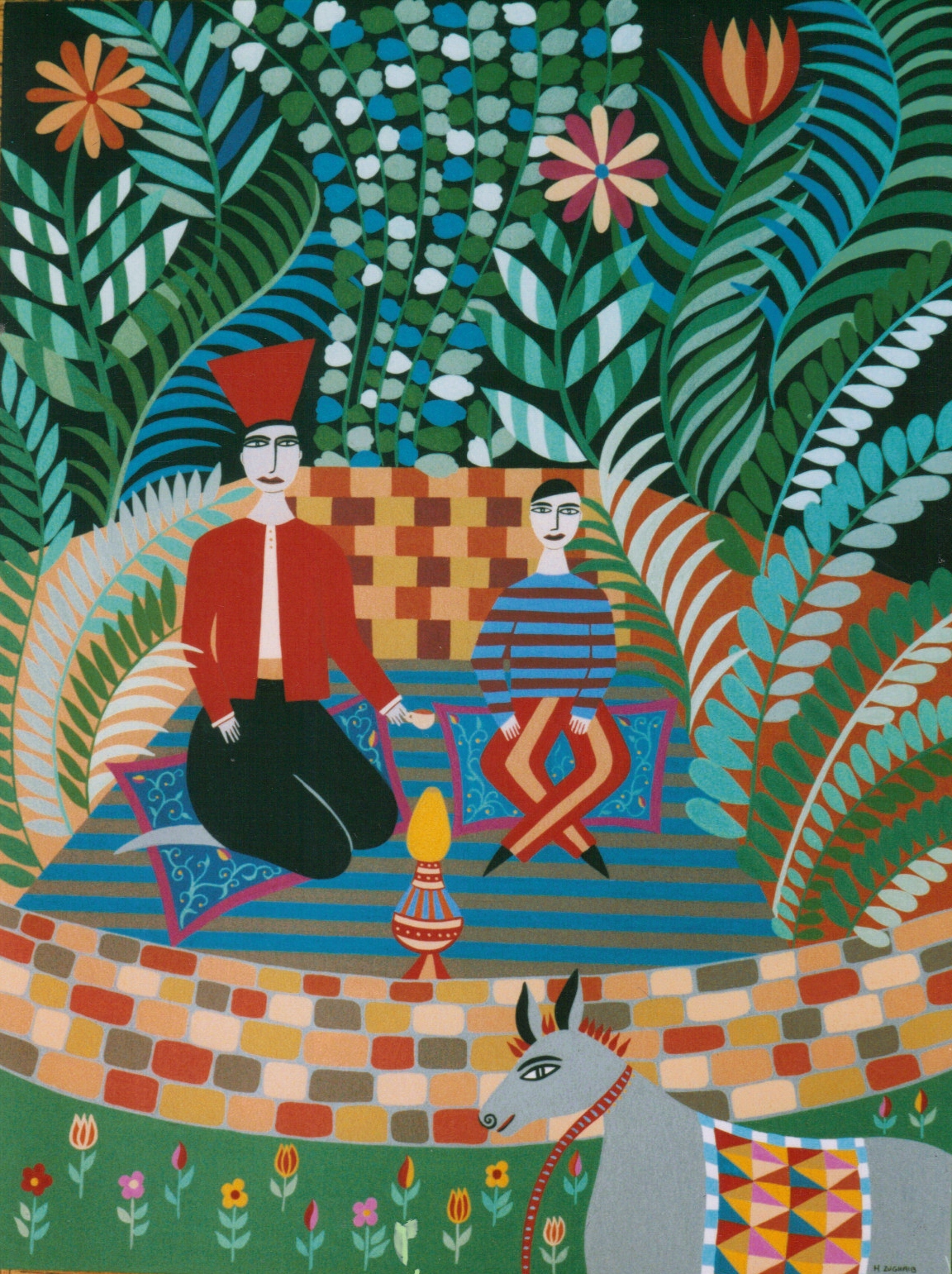 [Evenings in the Kroum (2004). Copyright the artist.]
[Evenings in the Kroum (2004). Copyright the artist.]
As told by my father: Every summer I spent several weeks in my grandparents` house in Zahle, a mountain village in Lebanon. The best part of the visit would be a trip Jiddu (grandfather) and I would make to the kroum (vineyards). There we would spend a week working in the kroum, talking, and just being together.
During the day, Jiddu and I worked in the field. He would tell me what to do and would explain to me why things were done in a certain way. Jiddu spent the day not just talking to me, but he would also talk to the trees and the grape vines as if they were people visiting us. In a way, the kroum had become intertwined with the family, part of the community. As he worked, he would tell me that this tree was planted when Uncle Jamil was born, this tree was planted when Aunt Wadi`a was married, or this vine was planted when As`ad was baptized. Every place in the vineyard was connected to something. Sometimes it related to national events, or world events, but mostly the connections were to family events. The fields and the kroum had become a diary of family history which he was passing on to me. Jiddu was also an authority on the wild plants and herbs which grew in and around the kroum. This is good for curing a cold, he would say. This is good for an upset stomach, and this is good to flavor a stew. We would collect many of these herbs and wild flowers and dry them to be used in winter.
Every evening, after supper, Jiddu would light the kerosene lamp, brew some herbal tea over the charcoal fire, and then begin to tell stories about our family. He would tell stories about those who had gone abroad, those who did well and those who did not-the good sheep and the black sheep. And then, if he wasn`t tired, Jiddu would recite poetry or tell stories which usually had a moral or lesson to learn.
He never preached to me but he always made sure I got the message. More than anything else, Jiddu loved poetry. He loved to recite poems and he loved to hear poetry being recited. Sometimes he would ask me to recite poems I had learned in school. I tried my best but I could not satisfy his thirst for hearing one poem after another. Once, when I was about thirteen, he asked me to recite poetry, but I could only remember one poem and part of another one. When I stopped reciting, he turned the kerosene lamp off and we went to sleep. The next night he asked me to recite more poetry. I repeated the same poem and part of another that I had recited the night before. Jiddu protested that this was the same poetry that I had recited the previous evening, and I confessed that it was all I knew. Jiddu looked at me for some time before saying that if after eight years of school, all I could remember was a poem and a half, then I was wasting my time, and my parents` money, and that I had better quit school and start working. After that, Jiddu never asked me to recite anything, but he continued to tell me stories, and to teach me about various plants in the Kroum. Poetry, however, never re-entered our life in the kroum.
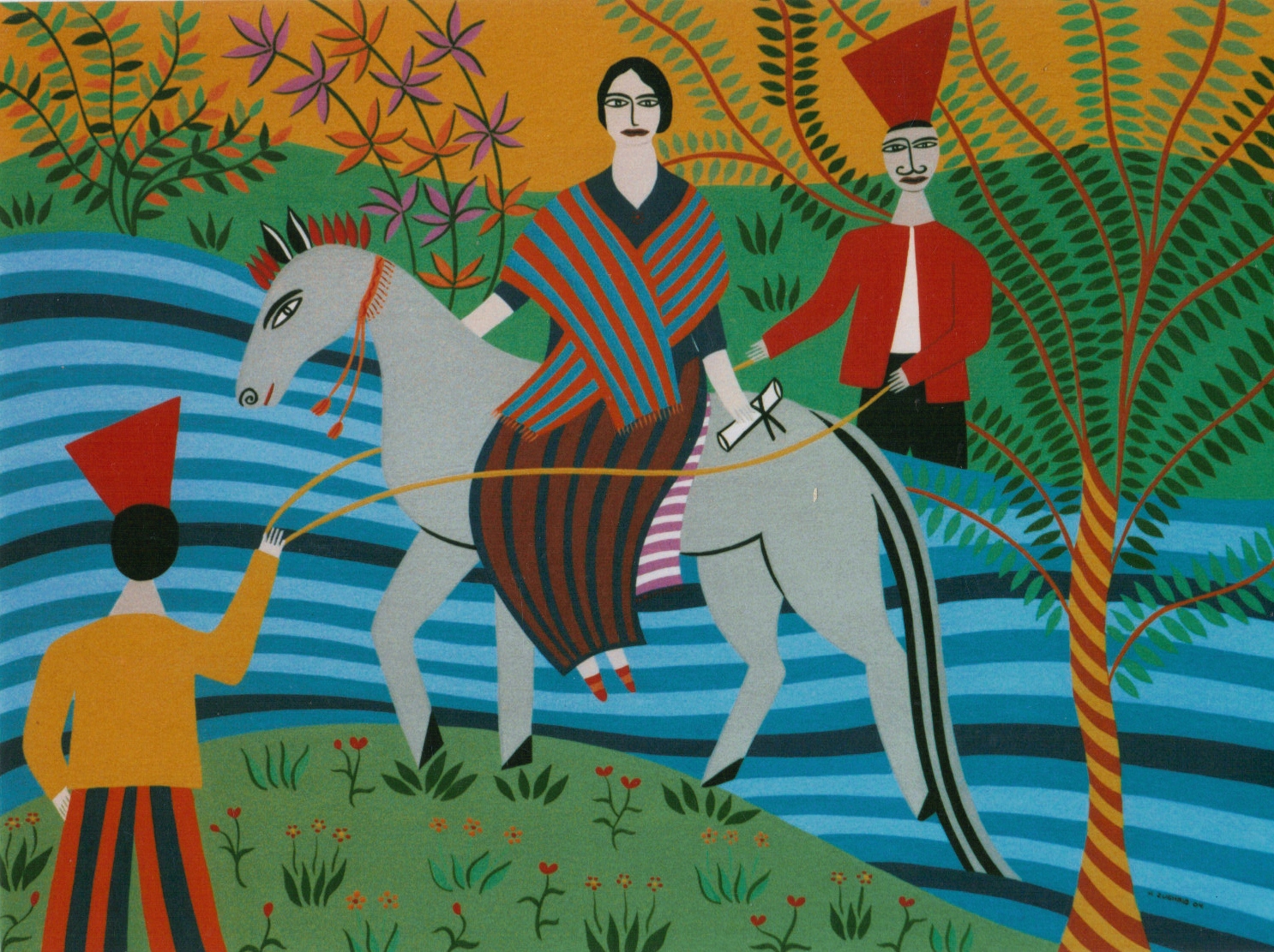 ["Crossing the Litani" (2005). Copyright the artist.]
["Crossing the Litani" (2005). Copyright the artist.]
In 1940-41, the British forces in Palestine attacked the Vichy French forces in Lebanon and Syria. One of the invasion routes was Jdeidet Marjyoun where my father lived with his sisters and mother. Everyone in the village decided to leave before the arrival of the troops. Clusters of people assembled in some disorder and began walking toward the Litani River.
Those who had brought food (zuwaidi) shared it. Except for the sound of artillery shells bursting in the distance, the whole event could have been described as a slowly moving picnic. They reached the river and waited for morning so they could cross. In the morning, my grandmother realized she had fled without any documents. She would not proceed without them and my father went back to get them. The trip was uneventful except for the stragglers who kept asking him why he was going in the wrong direction. He found the steel tube where his mother kept the papers, (birth certificates, identification documents, school diplomas, etc.) locked the house and began the long walk back. When he reached his family most of the others had already crossed the river, but my grandmother refused to leave without her son.
And then she admitted to another reason for not going -- her intense fear of riding a horse to cross. There were no alternatives. The river was deep and wide, the current fast and the fighting was getting closer. Three men and a horse were hired, one man to lead the horse and the other two to hold my grandmother on the horse. The crossing was noisy but safe, with Teta screaming and waving the metal tube with the papers all the way to the other bank. The owners of the horse, although their fee was doubled, vowed never to help another heavy and hysterical woman to cross the river.
View the complete series of "Stories My Father Told Me" here